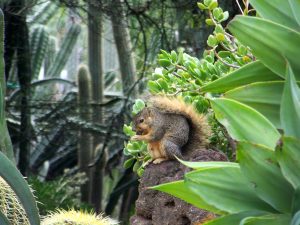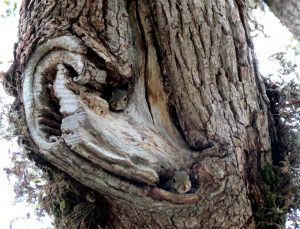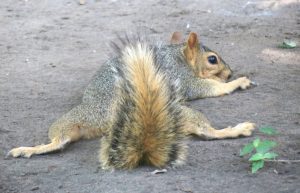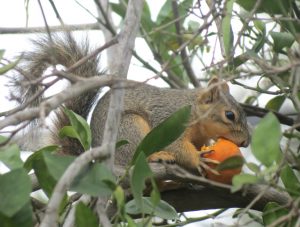by Julia Jorgensen

Descendants of ancient rodents, tree squirrels are found on every continent except Australia and Antarctica. North America is home to eight of the world’s twenty-six species. The eastern gray squirrel (Sciurus carolinensus) and the fox squirrel (Sciurus niger) are common in the eastern and southern U.S., while the western U.S. hosts the western gray squirrel, Abert’s squirrel, red squirrels (pine and Douglas), the Arizona gray squirrel, and the Mexican fox squirrel (found in southern Arizona).
Both eastern gray and fox squirrels have been introduced in urban environments around the U.S. and in Canada. Introduced eastern gray squirrels notoriously displaced the Eurasian red squirrel in the U.K. and Europe in the late 1800’s.
Tree squirrels strike many observers as highly adaptable. The public is fascinated with the squirrel’s agility, persistence, and problem-solving acumen, as evidenced in viral videos that pit squirrels against human engineers in the bird feeder wars, with squirrels winning every time.1
However, squirrels are threatened by global deforestation. When they are introduced into isolated or fragmented habitat, increasing density leads to aggression, nest crowding, weight loss, and reduced frequency of reproduction.2

Koprowski claims that “more than 80% of tree squirrels are in a precarious conservation status in some portion of their range.” Several subspecies have been listed as endangered in the U.S., including the Mt. Graham red squirrel in Arizona, the Big Cypress fox squirrel in Florida, and the Delmarva fox squirrel of Chesapeake Bay. In highly variable habitats, some North American species would require a restored population of at least 150 individuals to insure viability, although in the best case as few as 15 individuals might suffice.
However, tree squirrels can do well in some novel environments when food is not scarce. A high reproduction rate (which can occur even in low population density), along with a tendency to disperse, ability to create nests, Eastern gray squirrel nestling and a varied diet contribute to adaptability.
Body plan of the tree squirrel
The tree squirrel body plan is remarkably suited to arboreal life.3 It retains the rodent jaw and teeth, with incisors that grow throughout life. Permanent grinding molars render nut tannins more digestable.
The tree squirrel has a plantigrade stance and can land righted, with body extended, to soften falls. It has back thumbs and sharp claws; it can reportedly leap ten feet laterally and several feet straight up; it can run up to 16.7 mph on a flat surface. It has 180-degree foot rotation so it can descend trees headfirst. It can dog paddle in water for short distances, although reports exist from the 18-19th centuries of mass squirrel migrations that actually crossed rivers.
The tail can communicate aggression and divert predators, and it serves as a counterbalance, an umbrella in bad weather, and a thermoregulatory device. A nodule of blood vessels at the base of the tail cools blood when the tail is raised, and squirrels may lie flat on the ground in this position during hot weather.

Squirrels maintain a very high body temperature and metabolic rate, which in winter is one of the most extreme observed among animals. Squirrels in temperate climates may also gain ten percent more body weight for winter padding.
Tree squirrels are not sexually dimorphic, and sex can be hard to determine out of mating season, as the male’s testicles shrink up into the abdomen.
Vibrissae (whiskers) are tactile organs, heavily enervated and supplied with muscles at their base. Those on the tree squirrel’s muzzle are longer than whiskers of ground squirrels, and tree squirrels also have shorter vibrissae around the head, and on the back of the body, the abdomen, the feet, the elbows, base of the tail, and the wrists.
Squirrels have a powerful sense of smell. This may help them decide which food items to cache, and smell is key for males in detecting estrus females. Males have been observed to locate an estrus female from 929 yards downwind. Squirrels also sniff each other’s oral glands to greet, appearing to kiss.
The squirrel’s vision is remarkable, with a near 360 degree range, and ability to focus over the entire retina. Being diurnal, it has color vision (though with red-green color blindness), with yellowish pigmentation which may increase sharpness in bright light or protect from retinal damage.
The range of squirrel hearing is roughly two-and-a-half times greater than humans’, but shifted towards higher frequencies. Squirrels make a variety of species-specific calls.
Squirrel cognition is largely unexplored, but Hopewell4 discovered that squirrels can learn from observing peers, and Jacobs5 discovered that squirrels remember caching sites in detail, suggesting use of cognitive mapping. Baldwin6 found that the squirrel brain has a sensory processing area organized like its equivalent in tree shrews and primates, possibly reflecting a behavioral shift from use of the vibrissae in navigation to use of vision.
Lifestyle and ecology of gray and fox squirrels
Tree squirrels are potential indicators of forest health but data about their ecology is known for only about thirteen percent of species.7
While species vary in lifestyle and ecology, much of what we know about these subjects comes from the decades-long work of biologist John Koprowski and his colleagues who have completed detailed observational studies and field experiments with gray and fox squirrels.8
These mostly asocial species are not territorial and often mix in their home ranges. Highest natural density for the fox has been recorded as 12 individuals per 2.47 acres. Both species prefer pine hardwood forests where they make leaf or tree hollow nests. Grays are significantly smaller and prefer denser cover, while the fox likes forest/field edges. Grays will retreat to cover to eat, while the fox will stay in the open where it is foraging.
Feeding
Both species eat a great variety of foods—up to 97 types have been observed, going well beyond their preferred nuts and fruits to include fungi, insects, buds, bark, eggs, and even baby birds or squirrels. Licking road salt or bone may be ways of compensating for nutritional imbalances.

Tree squirrels are scatter hoarders and may have hundreds of cache sites to secure food for winter. The choice of which items to cache and which to eat is complex, but it seems to be driven by the relative perishability of items. Thus, the squirrel will cache acorns with delayed germination (and if it caches one that could sprout early, it will remove the embryo)9 and acorns with higher tannin content. It will eat rather than cache acorns infested with weevil larvae.
Koprowski et al have shown that these choices can affect the distribution of trees in a mixed red and white oak forest, suggesting that they may ultimately shape seedlings’ adaptations to shade and moisture.
Deceptive caching occurs 30 – 40% of the time. This intriguing behavior involves digging as many as nine extra holes for a single cached item, placing it in one hole, and covering some percentage of all the holes. This occurs even when a potential thief is far away, and is done more often when food is in decline. It’s possible that the empty holes reduce the chance that any thief will locate an acorn. The squirrel’s ability to relocate a cache may be due to smelling cached items but also to cognitive mapping.
Reproduction and lifespan
These squirrels do not pair bond, and there are many more males than females. Estrus occurs at most twice a year for about an eight-hour period. (In food-insecure years females may not come into heat.) Males range twice as far as females daily, simply in order to visit all female nests first thing in the morning to search for a female in estrus.
When estrus occurs, a mating bout ensues, with males chasing the female throughout the day, led by dominant males. The female usually ends up mating with two to four males, although up to 34 males have been observed in pursuit. Copulation takes about twenty seconds. Then the pair groom their genitals and the female may remove a copulatory plug left by the male. The male will guard the female for twenty minutes. By mid-afternoon the males lose interest.
The female bears two to three young for the first time when she is one to two years old. She cares for them alone, weaning at eight to 12 weeks. From birth to weaning, the young gain mass at a rate equivalent to that of a human neonate’s growing from 8 to 130 pounds in two months.
About half of the young survive the first year. In fox squirrels, all the young disperse by late spring, although young female gray squirrels often stay with their female kin in a communal nest of two to nine individuals. Then, fully 70 percent live to old age, which is about 12.5 years for females and eight to nine years for males.
- “Building the perfect squirrel proof bird feeder”, Mark Rober, engineer: https://www.youtube.com/watch?v=hFZFjoX2cGg Physicist’s attempt: https://www.youtube.com/watch?v=s4YthEm5qIk
- Koprowski, J.L. (2005) The response of tree squirrels to fragmentation: A review and synthesis. Animal Conservation.
- Steele, M.A. and Koprowski, J.L. (2001) North American Tree Squirrels. Smithsonian.
- Hopewell, L.J., Leaver, L.A., Lea, S. and Wills, A.J. (August 2009) Gray squirrels show a feature-negative effect specific to social learning. Animal Cognition.
- Jacobs, L.F. and Liman, E.R. (1991) Gray squirrels remember the locations of buried nuts. Animal Behavior.
- Baldwin, M.K., Young, N.A., Matrov, D., and Kaas, J.H. (2018) Cortical projections to the superior colliculus in gray squirrels. European Journal of Neuroscience.
- Koprowski (2005)
- Steele and Koprowski (2001)
- According to Steele and Koprowski, as of 2001, no one understood how host trees could survive this kind of seed dispersal.